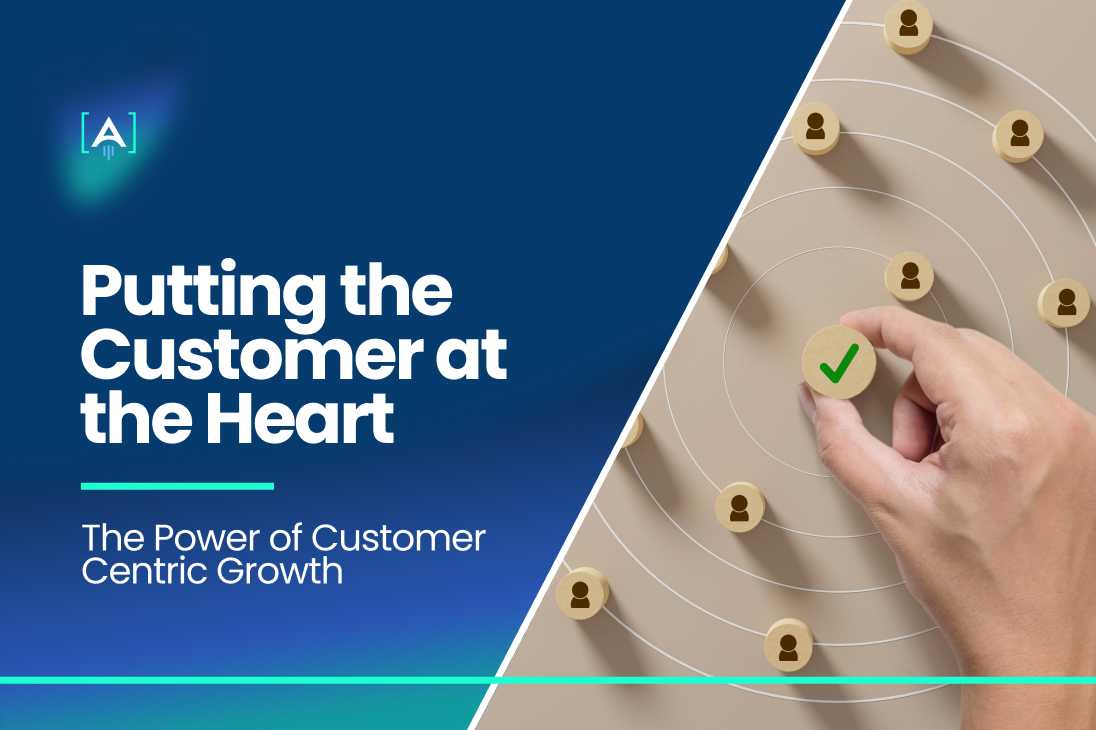In today’s hyper-competitive marketplace, becoming a customer-centric company is the pivotal difference between success and stagnation. What separates good companies from great ones? Is it innovative products? Aggressive marketing? Or perhaps efficient operations?
While all these elements play a part, there’s a more critical factor: putting the customer at the heart of everything.
Businesses prioritizing customer led marketing aren’t just practicing good ethics; they’re paving a golden pathway for growth.
This approach has proven to be profitable, with customer-centric companies being 60% more profitable than those not focusing on customers.
Dive with us into the world of customer centric marketing and discover the powerful engine it can be for growth.
Understanding Customer-Centricity
“Customer-centricity”: a buzzword you’ve probably heard a thousand times. But what does it truly mean, and more importantly, why should you care? Let’s unravel that together.
Back in the day, businesses pushed products and hoped customers would bite. Today, it’s the exact opposite. Companies now pivot around the customer, tailoring products and experiences based on their needs and preferences.
This is the seismic shift from product-led to customer-led customer led marketing. The transformation isn’t merely aesthetic; it’s foundational.
The key differentiators between customer-centric and other growth customer models? For starters, traditional models might focus on just the product or the bottom line. A customer-centric model, however, prioritizes the positive customer experience (CX) above all.
For instance, while a product-centric company might launch a feature because it’s innovative, a customer-centric one would do so only if it genuinely adds value to the customer.
But why this sudden spotlight on customer experience (CX)? Recent data sheds some light: 89% of consumers have switched to a competitor after a poor customer experience.
With stakes so high, it’s clear why CX is becoming the boardroom’s favorite topic.
The Benefits of Building a Customer-Centric Approach
While many businesses claim to value their customers, few genuinely center their entire strategy around them. Those that do, however, unlock a treasure trove of benefits.
Let’s delve into the perks of customer led marketing.
- Increased Customer Loyalty & Reduced Churn: Happy customers stick around. And why wouldn’t they? If you’re consistently meeting (or even exceeding) their expectations, they have no reason to look elsewhere. And remember: strong loyalty turns customers into promoters with a lifetime value 6-4x that of detractors.
- Enhanced Customer Lifetime Value (CLV): Loyal customers don’t just stick around; they also spend more. Those who have a positive experience are 140% more likely to spend than those who have a poor one.
- Referral Growth: Delight your customers and watch them become your brand ambassadors. Happy customers don’t keep their joy to themselves; they spread the word. In the world of growth marketing, there’s no advertisement as potent as word-of-mouth.
Types of Customer-Centricity:
Customer centric marketing comes in various forms, from building user communities and adapting experiences to ensuring wide product availability.
- Community-Based: Companies like HubSpot and Salesforce have built thriving communities where users share insights, troubleshoot issues, and even evangelize the product. This approach fosters a sense of belonging and deepens customer engagement, ultimately leading to organic demand generation through word-of-mouth marketing.
- Chameleon-Based: Think about Spotify. Its algorithms adapt based on your listening habits, giving you a unique experience.
- Commodity-Based: Walmart, with its integrated grocery service and customer-centric features, is a prime example of a company focusing on providing a wide range of products at the best prices, ensuring the customer always finds what they’re looking for.
The Psychology Behind Customer-Centricity
Now, let’s take a deep dive into the human psyche. Why do we crave personalization? What role do emotions play in our purchasing decisions?
- The Innate Human Need for Personalization: We all want to feel special, don’t we? Custom-tailored experiences signal to customers that they’re valued. In 2023, around three-quarters of customers worldwide expected better-personalized services in exchange for sharing more personal data with companies.
- The Value of Trust: Trust isn’t just a cornerstone of personal relationships; it’s equally pivotal in brand-customer relationships. When customers trust a brand, they’re more likely to stay loyal and even forgive occasional missteps. This trust is essential to deliver exceptional customer service.
- Understanding Customer Behavior: Ever wondered why Amazon’s recommendations are eerily accurate? That’s because they’ve invested heavily in understanding customer behavior and using those insights to inform growth.
- The Role of Emotions: Purchasing decisions aren’t just logical; they’re emotional. 80% of consumers feel more emotionally connected to a brand when customer service solves their problem, illustrating the significant role emotions play in brand loyalty.
Essential Tools for Customer-Centric Growth
In the digital era, companies aren’t merely competing on products or services—they’re competing on experiences. And as customer expectations evolve, so should our tools and techniques. Gone are the days of one-size-fits-all approaches; now, it’s all about tailored interactions.
With the right set of tools, businesses can create a customer-centric model that stands the test of time. But which are these tools, and why are they so indispensable?
Customer Feedback Platforms
Imagine going on a date and having your partner nod at everything you say without actually listening. Not fun, right? Just like in relationships, businesses need to genuinely listen to their customers. Enter Customer Feedback Platforms.
CARD Pioneer Microinsurance is a perfect example of a company that places significant value on getting feedback from customers and retooling based on these insights and metrics.
By integrating feedback loops into product and service development, businesses can constantly evolve based on their customer’s needs.
For instance, using AI for sentiment analysis allows brands like Yelp or TripAdvisor to gauge how users feel about particular reviews, helping them to highlight the most relevant content.
Customer Relationship Management (CRM) Systems
Picture a library. Instead of books, it’s filled with customer data. Each ‘book’ details a customer’s likes, dislikes, preferences, and history. That’s your CRM system. It centralizes customer data, offering unparalleled insights.
Tools like Salesforce or HubSpot offer segmentation options, allowing companies to send personalized marketing campaigns. This is crucial when trying to measure customer-centric culture.
Remember the last time you received a ‘recommended for you’ email? That’s predictive analytics at work, paving the way for proactive growth measures.
Customer Data Platforms (CDPs)
Dive deeper, and you’ll find CDPs. Think of them as librarians who know exactly which ‘books’ to fetch. These platforms collect and unify data from across multiple sources, giving businesses a panoramic view of each customer.
For instance, a retailer might use a CDP to see a customer’s online browsing habits and in-store purchases, creating a seamless shopping experience tailored to individual preferences.
Marketing Automation Platforms (MAPs)
Time is of the essence in today’s fast-paced world. MAPs, like Mailchimp or Marketo, help businesses stay on top without getting overwhelmed.
Automating tasks such as email marketing, social media marketing, and lead nurturing doesn’t just save time—it ensures consistency.
Think about the last automated email you received after abandoning your online cart. That’s a MAP working to rekindle your interest and potentially clinch a sale.
Personalization Engines
Ever visited a website and felt like it was designed just for you? Personalization engines are the artists behind that masterpiece. They craft unique customer journeys, adapting in real-time to user behavior.
These engines use both demographic (age, location) and psychographic (interests, values) data for sharp targeting.
For example, Spotify’s “Discover Weekly” playlist uses this tool to bring you songs tailored to your taste, blending what they know about your listening habits with what they understand about song patterns.
Metrics That Matter in Customer-Centric Growth
You wouldn’t drive a car without a dashboard, would you? In the world of customer-centric growth, metrics are that dashboard. They offer a real-time pulse of how well you’re meeting (or exceeding!) customer expectations.
However, not all metrics are created equal. Let’s dive into those that truly matter and shed light on your customer-centric journey.
Net Promoter Score (NPS)
One simple question: “On a scale of 0-10, how likely are you to recommend us to a friend or colleague?” This is the essence of NPS. It’s a golden tool for:
- Gauging customer satisfaction and loyalty: A high score means you’re doing things right. Take Apple, for example; their consistently high NPS is a testament to their product quality and customer service.
- Best practices for NPS surveys: Keep it short and timely, and always be open to feedback.
- Turning promoters into brand advocates: Those scoring 9-10 on your NPS are your promoters. Encourage them to spread the word, maybe through referral programs or sharing testimonials.
Customer Satisfaction Score (CSAT)
Ever filled out a survey that asked, “How satisfied were you with your purchase?” That’s CSAT. It provides a snapshot of how you’re doing right after a purchase or interaction.
- Understanding immediate post-purchase feelings: Post-purchase surveys like Amazon’s ensure a company maintains its service standards. Integrating CSAT into regular feedback mechanisms can help identify areas for improvement and enhance customer satisfaction. This approach becomes even more crucial, considering that 93% of customers expect a brand to reply to them within 24 hours.
- Implementing corrective actions: If a product gets consistently low CSAT scores, it’s time to revisit its features or check for quality issues.
- Integrating CSAT into regular feedback mechanisms: Rather than being a one-off, integrate CSAT into every touchpoint, from website interactions to product deliveries.
Customer Effort Score (CES)
How easy was it for you to use our service or product? This question drives CES.
- Evaluating the ease of customer experience: If a customer has to jump through hoops to buy from you, they’re likely not coming back. Think about Netflix‘s seamless streaming experience as a high CES example.
- Why reduced effort leads to increased loyalty: The less effort a customer has to exert, the happier they are. Simple as that.
- Strategies for simplifying customer interactions: Be it a straightforward return policy or an intuitive website design, always aim to reduce customer effort.
Customer Lifetime Value (CLTV)
It’s not just about acquiring new customers; it’s about keeping them. CLTV calculates the total worth of a customer over their entire relationship with a business.
Companies like Spotify focus on personalizing user experiences to enhance CLTV, ensuring customers remain subscribed month after month.
Increasing CLTV is directly correlated with an increase in revenue, as observed in 84% of companies that work to improve their customer experience.
Customer Churn Rate
This is the flip side of CLTV. The churn rate measures the number of customers who stop using your product or service over a certain period.
It’s a wake-up call for businesses. A high churn rate? It’s time to dive deep and understand what’s going wrong.
Examples of Customer-Centric Companies
- Amazon: With features like “1-Click Ordering” and personalized recommendations, shopping is a breeze.
- Google: Their user-friendly interface and constant innovations make them the go-to search engine.
- Apple: Their ecosystem ensures customers stay loyal and consistently buy into their suite of products.
- Netflix: Personalized show recommendations mean binge-watching never ends.
- Spotify: Tailored playlists ensure users always have the perfect soundtrack.
- HubSpot: Their all-in-one inbound marketing, sales, and service platform is built entirely around the customer’s needs.
While these metrics and examples provide a roadmap, the ultimate measure is customer happiness. When in doubt, always return to the basics: Are your customers happy? If not, what can you change? If yes, how can you make them even happier?
The answers will guide your customer-centric growth.
Strategies to Embed Customer-Centricity
Ever wished your favorite brands just ‘got’ you? That’s customer led marketing and customer-centricity in action. As brands evolve in today’s market, tuning in to the real voices and needs of customers is the secret sauce to lasting success.
Voice of the Customer (VoC) Programs
Think of a time when you shared your feedback about a product, and to your surprise, the company listened and made changes. VoC programs make this magic happen regularly.
Platforms like Starbucks’s “My Starbucks Idea” are shining examples of taking customer opinions seriously and turning them into concrete actions. And what’s better than seeing a brand act on your suggestion? They apply customer centric marketing.
Being rewarded for it! It’s a win-win, making customers feel genuinely valued.
While VoC programs and tailored experiences lay the foundation for happy customers, customer centric marketing goes beyond initial satisfaction. Here’s where a retention strategy comes into play.
Weaving Retention Strategies with Growth
A growth marketer, for example, understands the power of keeping existing customers engaged with the help of customer centric marketing. They can craft targeted retention campaigns by analyzing VoC data and user behavior. This might involve loyalty programs, exclusive content, or even personalized recommendations – all designed to keep customers coming back for more.
Tailored Customer Experiences
Ever noticed how Spotify seems to know just the song you’re in the mood for? Is it customer centric marketing? That’s tailored customer experience at its best. With personalized content strategies, brands aim to fit into each customer’s unique world.
As a user’s journey with the brand evolves, every interaction gets fine-tuned, offering context and relevance that’s hard to ignore.
Emphasizing Emotional Connections
Remember that ad that almost made you tear up? Brands now strive for those deep connections, not just through storytelling but by embodying values that resonate.
Consider Apple; it’s not just about cutting-edge gadgets. Their story of innovation and simplicity has struck a chord with millions.
Injecting genuine empathy in customer interactions transforms a mundane service call into an experience of being truly heard and understood. By cultivating a community that believes in a brand’s values, companies aren’t just selling; they’re building relationships.
Overcoming Challenges in Customer-Centric Growth
Embracing a customer led marketing isn’t without its roadblocks. But knowing what they are and how to tackle them makes the journey smoother.
Aligning Teams with the Customer-Centric Vision
- Education: It’s one thing to declare a customer-first approach, but making it a reality requires educating teams. Take the case of Zappos, which transformed its entire company culture to prioritize customer happiness.
- KPI Integration: Simply put, what gets measured gets managed. Introducing customer-centric KPIs like Net Promoter Score into evaluations ensures alignment.
- Silos Be Gone: Siloed operations can hinder a unified approach. When marketing and product development teams collaborate, the result is often a superior customer experience.
Balancing Data Privacy with Personalization
- Regulation Insight: GDPR, CCPA — these aren’t just jargon. Brands like Apple lead the way in prioritizing user data privacy while still offering personalized experiences.
- Ethics First: In a world of data breaches, ethical use of customer data isn’t just right – it’s smart business. Honesty and integrity in handling data can turn potential pitfalls into trust-building opportunities.
- Transparent Practices: Clarity in how customer data is used, like Spotify‘s easy-to-understand user agreements, fosters trust and assures users their information is in safe hands.
Adapting to Evolving Customer Expectations
- Stay Updated: It’s crucial to keep a finger on the pulse. Regular market research can reveal shifts in customer desires and preferences.
- Agile is King: Speedy adaptation to change is no longer optional. Companies like Netflix constantly iterate their platforms, ensuring they’re always several steps ahead in meeting user expectations.
- Future-Proofing: Anticipate. Prepare. Repeat. Brands that look beyond the horizon, embracing upcoming trends, find themselves less often caught off-guard.
Stat Check: In 2021, 44.5 percent of organizations worldwide viewed customer experience (CX) as their primary competitive edge. This emphasis is a testament to how central the customer has become in the grand scheme of business strategy.
Incorporating Technology in Customer-Centric Growth
The digital age is upon us, transforming not just how businesses operate but also reshaping the customer experience landscape. Today, technology is the bridge that connects businesses to their customers in meaningful ways.
The Role of AI and Machine Learning
Imagine knowing what your customers want before they even articulate it. By predicting customer needs and preferences, brands are steps ahead, ensuring their offerings resonate with their audience.
When it comes to automating personalized customer experiences, AI marketing isn’t just a back-end tool; it’s front and center in shaping unique journeys for every individual. Netflix, with its tailored movie and series suggestions, is a testament to this personalization at scale.
And decisions? No longer based on just hunches. Enhancing decision-making through data insights has propelled companies to make strategic moves. Amazon’s recommendation engine, an AI-driven marvel, boosts its sales by a significant percentage.
The Emergence of Chatbots and Virtual Assistants
Picture this: It’s 2 AM, and there’s a customer halfway across the world with a query. With 24/7 customer support and instant response, businesses ensure that no customer is left in the dark. Companies like Sephora have chatbots that assist users anytime, anywhere.
Tailored product recommendations aren’t just for big-ticket items. Chatbots, understanding users’ needs in real-time, often suggest products that the customer might find interesting. For example, Nike’s chatbot assists shoppers in finding the perfect pair of shoes.
Feedback is gold. It’s a valuable tool to improve your customer relationships. Gathering customer feedback in real-time through chatbots allows businesses to adjust and adapt on the fly. HubSpot’s GrowthBot, for instance, provides marketing tips and listens to users’ feedback for continuous improvement.
By 2025, it was projected that businesses would manage 95% of their customer interactions without human involvement, thanks to technologies like chatbots. This showcases how integral technology has become in crafting modern customer experiences.
Cultivating a Customer-Centric Culture
Ever thought about what really makes a business thrive? At the heart of it all is a vibrant, customer led marketing and culture. Let’s explore how to cultivate this!
Employee Training and Development
- Feeling the customer’s pulse: It’s not just about understanding what they’re saying but truly feeling their joys and pain points. This is where reinforcing the importance of customer empathy comes in. Imagine having every conversation drenched in genuine compassion and care.
- Walk a mile in their shoes: Have you ever role-played? Doing role-playing scenarios to handle customer concerns isn’t child’s play; it’s about preparing teams for those unpredictable customer moments, ensuring they shine every single time.
- Stay ahead of the curve: The world changes fast! And so do customer expectations. By upgrading skills to meet evolving customer needs, the business ensures it’s always a step ahead, ready to dazzle and delight.
Leadership’s Role in Championing the Customer
- Setting the stage: The tone at the top matters. When leadership is setting the tone and direction for a customer-focused approach, everyone listens. Everyone aligns.
- Walk the talk: Imagine a leader who not just talks the talk but truly leads by example in customer interactions. It’s like a lighthouse, signaling to the entire organization the cherished value of each customer interaction.
- Pop the champagne: Success tastes better shared. Celebrating and rewarding customer-centric achievements isn’t just about recognition—it’s a pat on the back, an encouragement to keep innovating for the customer.
Internal Feedback Loops
- Teamwork makes the dream work: Picture this – product, marketing, and sales all dancing in harmony. That’s what happens when these departments collaborate. The result? Seamless, delightful customer experiences.
- Stories that shape us: Every customer interaction weaves a tale. By sharing customer success stories and pain points, the business doesn’t just learn; it evolves, ensuring the next chapter is even more enthralling.
- Many minds, one goal: Ideas sparkle brightest when minds meet. Encouraging cross-departmental brainstorming sessions is like sprinkling magic dust, birthing solutions that resonate deeply with customers.
Future Trends in Customer-Centric Growth
As we navigate the dynamic terrain of customer-centricity, several transformative trends await on the horizon, promising to redefine our relationship with customers.
The Rise of Ethical Consumerism
Dive deep into the mindset of today’s customers, and you’ll find an informed advocate who seeks brands reflecting their values.
This isn’t just about eco-friendly packaging or ethically sourced ingredients. It’s an entire movement where understanding the informed and conscious customer is paramount.
Brands are rapidly aligning their core principles, not just to the latest market fads, but to societal and environmental causes. And the key to earning trust? Absolute transparency in sourcing, operations, and business practices.
The Era of Hyper-Personalization
Gone are the days when personalization was a mere ‘Dear [Your Name]’ in emails. Today, the narrative has shifted towards moving beyond general demographics to individual behavior.
Every interaction is an opportunity for brands to show customers they’re seen and heard, crafting experiences down to individual preferences.
But here’s the twist – as brands inch closer, they must ensure the dance doesn’t step on toes, striking the right balance between personalization and intrusiveness.
It’s interesting to note that this effort is worthwhile as consumers are willing to pay a 16% price premium for a great customer experience, demonstrating the tangible value of a customer-centric approach.
The Integration of Omnichannel Experiences
In the realm of customer-centricity, consistency is king. And that’s what it’s all about – offering a seamless brand experience across physical and digital touchpoints. Imagine your favorite store recognizing your online preferences or an online service recalling your offline inquiries.
By analyzing multi-channel customer journeys, brands can stitch these interactions into a coherent narrative. And behind the scenes? Cutting-edge technology, leveraging every tool at its disposal to connect disparate channels, ensures that customers always find familiarity, no matter the platform.
Customer-Centricity: The Heartbeat of Success
Diving deep into the world of customer-centric growth, it’s evident that the customer is more than just an audience; they are the pulsating heartbeat of every successful business story.
Through understanding, adapting, and genuinely connecting with them, brands can craft a tale not just of profitability but of genuine mutual value. So, as we wrap up, remember – keep your customers at the core, and success will undoubtedly follow!
A growth marketing agency can help you!











